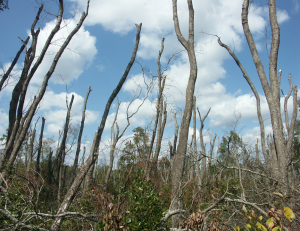
The number of forest tree species below the 75% sustainable regeneration deficit threshold within each provisional seed zone (Potter and Riitters 2021).
Genetic diversity is essential because it provides a basis for adaptation and resilience to environmental stress and change.
The fundamental importance of genetic variation is reflected by its inclusion in criteria and indicator (C&I) systems used to track forest sustainability at the national scale. One example is the Montréal Process Criteria and Indicators for the Conservation and Sustainable Management of Temperate and Boreal Forests. The United States is a participant in the Montréal Process C&I and uses it as a periodic forest sustainability assessment framework.
The first of the Montréal Process genetic diversity indicators (1.3.a) aims to quantify the number and geographic distribution of forest-associated species at risk of losing genetic variation and locally adapted genotypes. This indicator has been difficult to address in a systematic fashion, due to the large number of forest-associated species (including trees) native to the United States, and given the challenges inherent in quantifying the genetic diversity of species that are distributed across wide geographic regions.
A new publication, by Kevin Potter of North Carolina State University and Kurt Riitters of the USDA Forest Service’s Southern Research Station, combines two broad-scale datasets to inform this indicator for the United States: (1) tree species occurrence data from the national Forest Inventory and Analysis (FIA) plot network and (2) climatically and edaphically defined provisional seed zones, which are proxies for among-population adaptive variation.
Potter and Riitters calculated the estimated proportion of small trees (seedlings and saplings) relative to all trees for each species and within seed zone sub-populations, with the assumption that insufficient regeneration could lead to the loss of genetic variation. The threshold between sustainable and unsustainable proportions of small trees reflected the expectation of age–class balance at the landscape scale.
They found that 46 of 280 U.S. forest tree species (16.4%) may be at risk of losing genetic variation. California and the Southeast encompassed the most at-risk species. Additionally, 39 species were potentially at risk within at least half of the seed zones in which they occurred. Seed zones in California and the Southwest had the highest proportions of tree species that may be at risk.
The results could help focus conservation and management activities to prevent the loss of adaptive genetic variation within tree species.
The article was published in a special issue of the journal Forests focusing on Sustainable Forest Management Criteria and Indicators.
Read the full text of the journal article.
February 1, 2022




